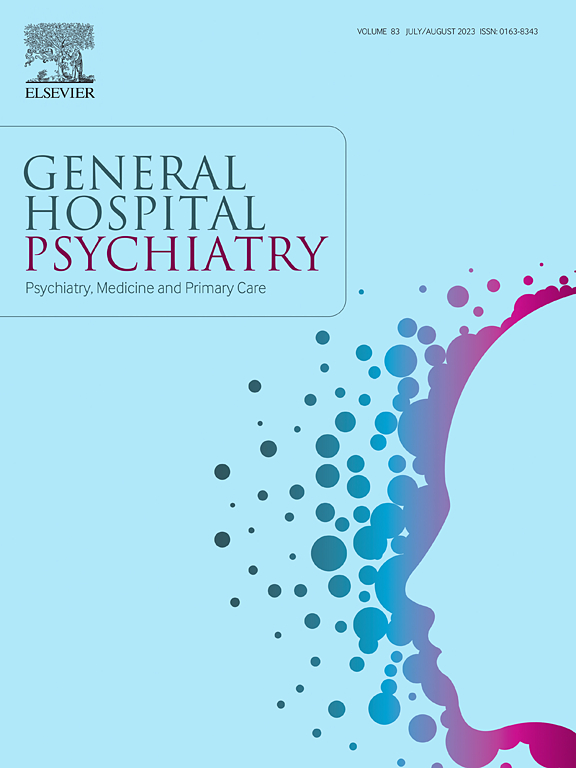Trajectories of depressive symptoms and the risk of cardiovascular, dementia, and pulmonary events in older adults: Evidence from the English Longitudinal Study of Ageing
IF 3.7
2区 医学
Q1 PSYCHIATRY
引用次数: 0
Abstract
Purpose
This research investigates the relationship between patterns of depressive symptoms over time and the likelihood of developing cardiovascular disease, dementia, and pulmonary conditions.
Methods
We examined 11,577 participants aged 50 and older. Depressive symptoms were measured using the Center for Epidemiologic Studies Depression Scale-8 (CESD-8). Group-based trajectory modeling was employed to categorize patterns of depressive symptoms, while Cox proportional hazards models were used to estimate hazard ratios (HR) and 95 % confidence intervals (CI). Sensitivity analysis for missing data was conducted using multiple imputation and data deletion methods, and the model's timeliness and stability were evaluated through time sensitivity analysis.
Results
Five distinct trajectories of depressive symptoms were identified: consistently low (n = 3353), decreasing (n = 127), increasing (n = 128), fluctuating (n = 7674), and consistently high (n = 295). Compared to the consistently low group, individuals with consistently high depressive symptoms faced significantly elevated risks of cardiovascular disease (HR = 1.65, 95 % CI = 1.38–1.98, P = 0.00), dementia (HR = 2.09, 95 % CI = 1.16–3.79, P = 0.02), and pulmonary diseases (HR = 3.12, 95 % CI = 2.41–4.05, P = 0.00). Fluctuating and increasing trajectories were also associated with higher risks, while the decreasing trajectory correlated with a reduced risk of dementia (HR = 0.77, 95 % CI = 0.62–0.95, P = 0.01).
Conclusion
Long-term patterns of depressive symptoms are strongly linked to the development of cardiovascular disease, dementia, and pulmonary diseases.
老年人抑郁症状的轨迹与心血管、痴呆和肺部事件的风险:来自英国老龄化纵向研究的证据
目的:本研究探讨抑郁症状模式与患心血管疾病、痴呆和肺部疾病的可能性之间的关系。方法我们对11577名50岁及以上的参与者进行了调查。使用流行病学研究中心抑郁量表-8 (CESD-8)测量抑郁症状。采用基于组的轨迹模型对抑郁症状模式进行分类,使用Cox比例风险模型估计风险比(HR)和95%置信区间(CI)。对缺失数据采用多种填入和数据删除方法进行敏感性分析,通过时间敏感性分析评价模型的时效性和稳定性。结果确定了5种不同的抑郁症状轨迹:持续低(n = 3353)、减少(n = 127)、增加(n = 128)、波动(n = 7674)和持续高(n = 295)。与持续低抑郁症状组相比,持续高抑郁症状的个体患心血管疾病(HR = 1.65, 95% CI = 1.38-1.98, P = 0.00)、痴呆(HR = 2.09, 95% CI = 1.16-3.79, P = 0.02)和肺部疾病(HR = 3.12, 95% CI = 2.41-4.05, P = 0.00)的风险显著升高。波动和增加的轨迹也与较高的风险相关,而减少的轨迹与痴呆风险降低相关(HR = 0.77, 95% CI = 0.62-0.95, P = 0.01)。结论抑郁症状的长期模式与心血管疾病、痴呆和肺部疾病的发展密切相关。
本文章由计算机程序翻译,如有差异,请以英文原文为准。
求助全文
约1分钟内获得全文
求助全文
来源期刊

General hospital psychiatry
医学-精神病学
CiteScore
9.60
自引率
2.90%
发文量
125
审稿时长
20 days
期刊介绍:
General Hospital Psychiatry explores the many linkages among psychiatry, medicine, and primary care. In emphasizing a biopsychosocial approach to illness and health, the journal provides a forum for professionals with clinical, academic, and research interests in psychiatry''s role in the mainstream of medicine.
 求助内容:
求助内容: 应助结果提醒方式:
应助结果提醒方式:


